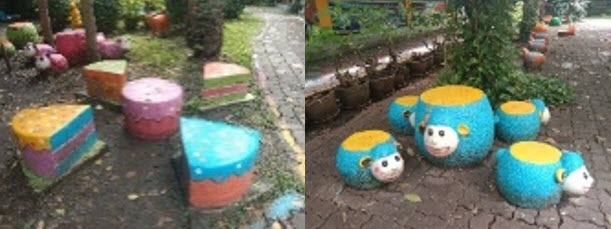ผลการจัดประสบการณ์เรียนรู้สะเต็มศึกษานอกห้องเรียนที่มีต่อทักษะการวัดของเด็กปฐมวัย
Main Article Content
Abstract
Samaporn Somsuk, Oraphan Butkatunyoo and Chalatip Samahito
รับบทความ: 5 พฤษภาคม 2568; แก้ไขบทความ: 25 พฤษภาคม 2568; ยอมรับตีพิมพ์: 26 พฤษภาคม 2568; ตีพิมพ์ออนไลน์: 20 มิถุนายน 2568
บทคัดย่อ
การศึกษานี้มีวัตถุประสงค์เพื่อศึกษาผลของการจัดประสบการณ์เรียนรู้สะเต็มศึกษานอกห้องเรียนที่มีต่อทักษะการวัดของเด็กปฐมวัย กลุ่มตัวอย่าง คือ เด็กอนุบาลปีที่ 3 จำนวน 30 คน ได้ มาโดยการชักตัวอย่างแบบกลุ่ม เครื่องมือที่ใช้การศึกษาคือแผนการจัดประสบการณ์เรียนรู้สะเต็มศึกษานอกห้องเรียน จำนวน 8 แผน แบบสังเกตและประเมินทักษะการวัดของเด็กปฐมวัย 1 ฉบับ 4 ด้าน ประกอบด้วย การวัดความสูง การวัดความยาว การชั่งน้ำหนัก การตวงปริมาตร เก็บรวบรวมข้อมูลเป็นระยะเวลา 8 สัปดาห์วิเคราะห์ข้อมูลเชิงปริมาณด้วยค่าเฉลี่ย ส่วนเบี่ยงเบนมาตรฐานและการทดสอบค่าทีและวิเคราะห์ข้อมูลเชิงคุณภาพด้วยการวิเคราะห์เนื้อหา ผลการศึกษาพบว่าเด็กปฐมวัยที่ได้รับการจัดประสบการณ์สะเต็มศึกษานอกห้องเรียนมีค่าเฉลี่ยของคะแนนหลังการจัดประสบการณ์ฯ สูงกว่าก่อนการจัดประสบการณ์ฯ ทั้งโดยรวมและรายด้านอย่างมีนัยสำคัญทางสถิติที่ .05 นอกจากนี้ยังมีการวิเคราะห์เนื้อหาจากบันทึกพฤติกรรมเด็กเพื่อให้ได้ข้อมูลเชิงลึกเกี่ยวกับผลของกิจกรรมการจัดประสบการณ์สะเต็มศึกษานอกห้องเรียน แสดงให้เห็นว่า การจัดประสบการณ์เรียนรู้สะเต็มศึกษานอกห้องเรียนนั้นสามารถพัฒนาทักษะการวัดของเด็กปฐมวัยได้ โดยเด็กสามารถเปรียบเทียบ เรียงลำดับและวัดสิ่งต่าง ๆ โดยใช้หน่วยที่ไม่เป็นมาตรฐานและเป็นมาตรฐานในกระบวนการสร้างชิ้นงานเพื่อแก้ปัญหาในบริบทจริง
คำสำคัญ: สะเต็มศึกษานอกห้องเรียน ทักษะการวัด เด็กปฐมวัย
Abstract
This study aimed to investigate the effects of implementing an outdoor STEM learning experience focused on the development of young children’s measurement skills. The participants were 30 third–year kindergarten children selected through cluster sampling. The research instruments included eight instructional plans designed for providing experiential learning activities outside the classroom, as well as an observation and assessment form of young children’s measurement skills, comprising four domains: height measurement, length measurement, weight measurement, and volume measurement. Data were collected over a period of eight weeks. Quantitative data were analyzed using mean, standard deviation, and t–test, while qualitative data were analyzed using content analysis. The findings indicated that young students who participated in the full–time outdoor STEM learning experience demonstrated a statistically significant improvement in their post–learning experience mean scores at the .05 level, both in overall measurement skills and across individual skill domains. Furthermore, qualitative analysis of behavioral observation records provided in–depth insights into the outcomes of the experiential learning activities. The findings suggest that implementing an outdoor STEM learning experience effectively enhances young children’s measurement skills. This is achieved by engaging young children in activities that promote comparison, sequencing, and measurement using both non–standard and standardized units, within authentic problem–solving contexts that support meaningful learning.
Keywords: Outdoor STEM education, Measurement skills, Young children
Downloads
Article Details

This work is licensed under a Creative Commons Attribution-NonCommercial 4.0 International License.
References
Bybee, R. W., Taylor, J. A., Gardner, A., van Scotter, P., Powell, J. C., Westbrook, A., and Landes, N. (2015). The BSCS 5E Instructional Model: Creating Teachable Moments. USA: NSTA.
Booker, G., Bond, D., Sparrow, L., and Swan, P. (2010). Teaching Primary Mathematics. 4th ed. Australia: Pearson.
Christenson, L. A., and James, J. (2022). Dig in: Outdoor STEM Learning with Young Children. USA: Gryphon House.
Equitable Education Fund. (2025). Research Findings Reveal: Investment in Early Childhood and Primary Education Yields the Highest Impact on PISA Scores. Retrieved from https://www.eef.or.th/news-070225, April 27, 2025.
Faculty of Educational Psychology and Guidance, Kasetsart Universiy. (2022). Educational Psychology and Guidance for Teachers. Bangkok: Author. (in Thai)
Institute for the Promotion of Teaching Science and Technology. (2017). Learning Framework and Guidelines for Integrating Science, Technology, and Mathematics Learning Experiences in Early Childhood Education According to the Early Childhood Education Curriculum B.E. 2560 (2017). Bangkok: Author. (in Thai)
Institute for the Promotion of Teaching Science and Technology. (2020). STEM Education. Bangkok: Author. (in Thai)
Institute for the Promotion of Teaching Science and Technology. (2023). PISA 2022 Assessment Results. Retrieved from https://pisathailand.ipst.ac.th/news-21/, April 27, 2025.
Lertdechapat, K., and Thanetweeraphat, A. (2023). Cross–cutting concepts in STEM learning activity design. Journal of Research Unit on Science, Technology and Environment for Learning 14(1): 79–93. (in Thai)
Magiera, M. T. (2010). Developing Preservice Teachers’ Mathematical and Pedagogical Knowledge Using an Integrated Approach. Milwaukee, WI: Marquette University.
Matchimo, M. (2023). The experiences provision of the inquiry towards observation skills classification skills and measurement skills of early childhood. Journal of Sethawit Review 3(3): 187–202.
Ministry of Education. (2017). Indicators and Core Learning Content for Mathematics (Revised Edition 2017) According to the Basic Education Core Curriculum B.E. 2551 (2008). Bangkok: Cooperative Printing House of Thailand. (in Thai)
National Council of Teachers of Mathematics. (2024). Principles and Standards for School Mathematics. Reston, VA: NCTM.
Paweenbampen, P. (2023). Development of integrated STEM activities to promote thinking process skills for the 21st century of Grade 1 students (La–or Plus project) at La–orutis Demonstration School. Journal of Inclusive and Innovative Education 7(1): 128–142. (in Thai)
Piaget, J., Inhelder, B., and Szeminska, A. (1960). The Child’s Conception of Geometry. UK: Routledge.
Pitiporntapin, S., Butkatunyoo, O., Piyapimonsit, C., Thanarachataphoom, T., Chotitham, S., and Lalitpasan, U. (2023). The development of a professional development model focusing on outdoor learning resources to enhance in–service teachers’ STEM literacy. Kasetsart Journal of Social Sciences 44(4): 489–496. (in Thai)
Pitiporntapin, S., Butkatunyoo, O., Piyapimonsit, C., Thanarachataphoom, T., Chotitham, S., and Lalitpasan, U. (2024). The influence of outdoor STEM activities on students’ STEM literacy: A study of elective subjects, extracurricular activities, and student clubs. Journal Pendidikan IPA Indonesia 13(2): 265–273.
Pooreeprechaleard, S., Chindanurak, T., and Thammaprateep, J. (2020). Development of the Instructional Model–Based on the Integrated STEM Education Approach to Enhance Nature of Science Understanding, Creative Thinking in Science and Productive Ability for Lower Secondary Students in State University Demonstration Schools. Journal of Research Unit on Science, Technology and Environment for Learning 11(1): 83–114. (in Thai)
Puchongprawet, J., Pongsophon, P., and Jantarakantee, E. (2025). STEM education through out–of–classroom contexts: A new dimension for developing creative problem–solving skills. Journal of Educational Studies, Chulalongkorn University 53(1): JESCU5301002. (in Thai)
Szilagyi, J., Clements, D. H., and Sarama, J. (2013). Young children’s understandings of length measurement. Journal for Research in Mathematics Education 44(3): 581–620.
Thiemake, H. (2024). The Effects of STEM–Based Learning Management Using the Engineering Design Process on Preschoolers’ Reasoning Skills at Wat Khok Pa Paeng School, Prachinburi Province. Master Thesis in Early Childhood Education. Bangkok: Phranakhon Rajabhat University. (in Thai)
Wadsworth, B. J. (1996). Piaget’s Theory of Cognitive and Affective Development: Foundations of Constructivism. New York: Longman.
